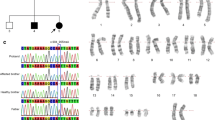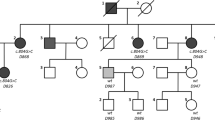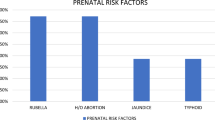Abstract
Background
Mutations in the GJB2 gene, which encodes the protein connexin 26 and is involved in inner ear homeostasis, are identified in approximately 50% of patients with autosomal recessive nonsyndromic hearing loss, making it one of the primary causes of prelingual nonsyndromic hearing loss in various populations. The 35delG mutation, one of the most common mutations of the GJB2 gene, usually causes prelingual, bilateral mild to profound, nonprogressive sensorineural hearing loss.
Case presentation
We present an unusual case of an 18-year-old Turkish female with heterozygous 35delG mutation and postlingual, profound-sloping, progressive and fluctuating unilateral sensorineural hearing loss. The phenotype is different from the usual findings.
Conclusions
The 35delG mutation causing hearing loss may not always be reflected in the phenotype as expected and therefore may have different audiologic manifestations.
Similar content being viewed by others
Introduction
In developed countries, more than 50% of sensorineural hearing loss (SNHL) cases have a genetic origin; 30% are syndromic, and the remainder are nonsyndromic [1, 2]. Mutations in the gap junction beta 2 protein (GJB2) gene, which encodes the protein connexin 26 and is involved in inner ear homeostasis, are found in approximately 50% of patients with autosomal recessive nonsyndromic hearing loss [2] and is one of the most important causes of prelingual nonsyndromic hearing loss in various populations [3]. The most common mutations of the GJB2 gene, which may vary among different ethnic groups, are 35delG, 167delT and 235delC [4, 5]. The deletion of a single guanine at position 30–35 in the GJB2 gene, known as 35delG, accounts for 70% of mutant alleles [4].
Since 1997, when GJB2 was reported to be the first autosomal recessive gene associated with nonsyndromic SNHL [1], many studies have been published in the literature on the auditory phenotype of mutations in the GJB2 gene [1,2,3]. However, the type of mutation in the GJB2 gene is also an important factor affecting the auditory phenotype. In general, the hearing loss phenotype of 35delG mutations in the GJB2 gene is prelingual, bilateral, mild to profound, sensorineural and nonprogressive [1, 2, 6, 7]. However, cases with progression and postlingual onset have also been reported [1, 3].
Unlike the SNHL phenotypes observed in most 35delG mutations in the literature, we present a patient with a postlingual, profound-sloping, progressive and fluctuating unilateral SNHL phenotype. We thought that our case report could contribute to the audiological evaluation and diagnosis processes of such unusual cases.
Case presentation
Informed consent was obtained from the patient’s parent to share the test results and patient information. The patient was an 18-year-old Turkish female. She was born prematurely at 37 weeks of gestation by vaginal delivery without any known complications during pregnancy. Because she was born prematurely, her lungs were underdeveloped. Therefore, she stayed in the incubator for 10 days after her birth and then passed the newborn hearing screening for both ears. At the age of 17 years, her hearing and speech had normally developed. The patient was also diagnosed with epilepsy and rosacea. She was taking sodium valproate (500 mg) and levetiracetam (1000 mg) for epilepsy treatment. There was no known history of other metabolic diseases, physical abnormalities or consanguineous marriages.
Audiological evaluation
The patient was admitted to our clinic in November 2022 with a complaint of hearing loss (HL) in her left ear. Hearing evaluation revealed findings consistent with moderate (PTA: 45 dB HL) SNHL with a severe sloping configuration on the left ear (Fig. 1). The second hearing evaluation was performed on April 2023, and the findings were consistent with moderately severe (PTA: 58 dB HL) SNHL with a profoundly sloping configuration on the left ear (Fig. 1). The third hearing evaluation was performed in August 2023, and the findings were consistent with moderately severe (PTA: 70 dB HL) SNHL with a profoundly sloping configuration on the left ear (Fig. 1). A recent hearing evaluation was performed in September 2023, and the findings were consistent with moderate (55 dB HL) SNHL with a profoundly sloping configuration on the left ear (Fig. 1). The speech discrimination scores for the left ear in the four tests were as follows: 64%, 20%, 20% and 44%. As a result of all hearing evaluations, findings compatible with normal hearing were observed for the right ear. A profound sloping configuration was observed in all hearing tests performed on four different dates.
As a result of the immittance assessments, bilateral type A tympanograms were obtained. The acoustic reflex was measured at all frequencies in the right ear but only at 500 Hz in the left ear.
Transient Oto-Acoustic Emission (TEOAE) and Distortion Product Oto-Acoustic Emission (DPOAE) responses were present in the right ear, while no response was detected in the left ear.
In the ABR test performed in September 2023, wave V was obtained at 10 dB nHL in the right ear and 80 dB nHL in the left ear (Fig. 2). Wave morphology was distorted in the left ear. Cochlear microphonics were not obtained.
No pathological findings were found as a result of temporal MRI due to the existence of asymmetric hearing loss.
Genetic evaluation
Whole exome sequencing analysis of DNA isolated from the patient's peripheral blood at the Medical Genetics Laboratory using next-generation sequencing revealed that the "pathogenic" p.G12Vfs*2 (c.35del) frameshift mutation in the GJB2 gene was heterozygous.
Discussion
Among the nonsyndromic causes of hearing loss, the Connexin 26 (Cx26) gene mutation, encoding the autosomal recessive DFNB1 phenotype, is the most common. The main pathological mechanism of hearing loss caused by GJB2 mutation is still unclear [8]. K + circulation, columnar cell cytoskeletal developmental defects, changes in Ca2 + signaling, ATP release and Ca metabolism, and cochlear macrophages participating in the process of OHC loss are considered among the possible causes [8].
Although 35delG is the most common genotype with a prelingual, bilateral mild to profound, nonprogressive SNHL phenotype [1, 2, 5,6,7], here, we report an unusual case of a patient with a heterozygous 35delG mutation with a postlingual, profound-sloping progressive and fluctuating unilateral SNHL phenotype.
As a congenital anomaly that has genetic origins, most of the cases are postlingual SNHL [9]. Wingard and Zhao suggested that postlingual SNHL may result from impaired active cochlear amplification due to Cx26 deficiency [10]. In the present case, the patient's hearing complaints appeared only in the left ear at the age of 17 years.
Although 35delG mutations are generally known to affect both ears, Lee et al. reported that individuals with heterozygous mutations in GJB2, the gene associated with 35delG mutations, showed more asymmetric SNHL than those with homozygous mutations [7]. Additionally, the degree of hearing loss in individuals with GJB2 mutations can be variable, and the degree of hearing loss associated with all reported genotypes has not been demonstrated [11]. Hilgert et al. reported that hearing loss ranges from mild to moderate (least frequent) or severe to profound (most frequent) and that in addition to familial factors, this phenotypic variation can be explained by the influence of environmental factors, modifier genes and/or other connexin genes [12]. Salvinelli et al. reported that the residual audiogram configuration in 35delG homozygous patients was more common, whereas the gently sloping configuration was more common in 35delG heterozygous individuals [6]. Marlin et al. documented progressive hearing loss in 22% of 256 subjects and concluded that although DFNB1 hearing loss is mostly stable, it can also be progressive [13]. The first three hearing assessments of the patient demonstrated that the SNHL in the left ear had progressed and that the right ear was stable. At the fourth evaluation, a slight improvement in the left ear hearing threshold was observed, and this finding was interpreted as fluctuating hearing loss. To our knowledge, there are no patients with fluctuating SNHL due to the 35delG mutation.
In some of the case reports on GJB2, OAE and ABR tests were also performed [14]. In the present case, TEOAE and DPOAE responses were present in the right ear but not in the left ear. According to the ABR results, wave V was obtained at 10 dB nHL in the right ear and 80 dB nHL in the left ear. Cochlear microphonics were not obtained bilaterally. The OAE and ABR findings were consistent with the behavioral thresholds. Given that temporal MRI was also normal, the results allowed us to exclude the possibility of an auditory neuropathy spectrum disorder or any retrocochlear pathology.
Mutations in the GJB2 gene may cause skin abnormalities in addition to hearing loss. In the literature, these mutations may be responsible for keratitis- ichthyosis- deafness (KID) syndrome, palmoplantar keratoderma (PPK) syndrome, Vohwinkel syndrome, and extensive hyperkeratotic lesions in the skin [15]. Our patient was also diagnosed with rosacea. There is no evidence in the literature showing that mutations in this gene are associated with rosacea disease. Therefore, it is not clear whether this disease is related to the GJB2 mutation.
Conclusion
We described an unusual case of a heterozygous 35delG mutation with postlingual, profound-sloping progressive and fluctuating unilateral SNHL with a phenotype different from common findings. The 35delG mutation causing hearing loss may not always be reflected in the phenotype as expected and may have different audiologic manifestations. In patients with a history of unilateral SNHL that occurs in a short period of time, a detailed anamnesis of the importance of imaging methods, genetic examination and audiologic tests in the diagnostic process should be performed. Genetic counseling should be provided to individuals with genetic hearing loss and their families. Regular follow-up of these individuals is very important to provide appropriate interventions for hearing loss.
Availability of data and materials
Data sharing is not applicable to this article, as no datasets were generated or analyzed during the current study.
References
Kenna MA, Feldman HA, Neault MW, Frangulov A, Wu BL, Fligor B, et al. Audiologic phenotype and progression in GJB2 (connexin 26) hearing loss. Arch Otolaryngol Head Neck Surg. 2010;136(1):81–7.
Snoeckx RL, Huygen PLM, Feldmann D, Marlin S, Denoyelle F, Waligora J, et al. GJB2 mutations and degree of hearing loss: a multicenter study. Am J Hum Genet. 2005;77(6):945–57.
Kokotas H, Theodosiou M, Korres G, Grigoriadou M, Ferekidou E, Giannoulia-Karantana A, et al. Sudden hearing loss in a family with GJB2 related progressive deafness. Int J Pediatr Otorhinolaryngol. 2008;72(11):1735–40.
Mahdieh N, Rabbani B. Statistical study of 35delG mutation of GJB2 gene: a meta-analysis of carrier frequency. Int J Audiol. 2009;48(6):363–70.
Geden H, Seneldir L. Connexin 26 (GJB2) mutations associated with congenital hearing loss in a country of different migration routes: Turkey. Indian J Otolaryngol Head Neck Surg. 2023;75(Suppl 1):628–34.
Salvinelli F, Casale M, D’Ascanio L, Firrisi L, Greco F, Baldi A. Hearing loss associated with 35delG mutation in Connexin-26 (GJB2) gene: audiogram analysis. J Laryngol Otol. 2004;118(1):8–11.
Lee KH, Larson DA, Shott G, Rasmussen B, Cohen AP, Benton C, et al. Audiologic and temporal bone imaging findings in patients with sensorineural hearing loss and GJB2 mutations. Laryngoscope. 2009;119(3):554–8.
Wang Y, Jin Y, Zhang Q, Xiong Y, Gu X, Zeng S, et al. Research progress in delineating the pathological mechanisms of GJB2-related hearing loss. Front Cell Neurosci. 2023. https://doi.org/10.3389/fncel.2023.1208406.
Markova T, Alekseeva N, Lalayants M, Ryzhkova O, Shatokhina O, Galeeva N, et al. Audiological evidence of frequent hereditary mild, moderate and moderate-to-severe hearing loss. J Pers Med. 2022;12(11):1843.
Wingard JC, Zhao HB. Cellular and deafness mechanisms underlying connexin mutation-induced hearing loss—a common hereditary deafness. Front Cell Neuroscie. 2015. https://doi.org/10.3389/fncel.2015.00202.
Hişmi BÖ, Yilmaz ST, Incesulu A, Tekin M. Effects of GJB2 genotypes on the audiological phenotype: variability is present for all genotypes. Int J Pediatr Otorhinolaryngol. 2006;70(10):1687–94.
Hilgert N, Huentelman MJ, Thorburn AQ, Fransen E, Dieltjens N, Mueller-Malesinska M, et al. Phenotypic variability of patients homozygous for the GJB2 mutation 35delG cannot be explained by the influence of one major modifier gene. Eur J Hum Genet. 2009;17(4):517–24.
Marlin S, Feldmann D, Blons H, Loundon N, Rouillon I, Albert S, et al. GJB2 and GJB6 mutations: genotypic and phenotypic correlations in a large cohort of hearing-impaired patients. Arch Otolaryngol Head Neck Surg. 2005;131(6):481–7.
Lan X, Lan X, Sun S, Niu L, Zhang C, Chen X, et al. Case report: Novel GJB2 variant c.113T>C associated with autosomal recessive nonsyndromic hearing loss (ARNSHL) in a Han family. Medicine. 2019;98(50):e18253.
Güleç Ç, Aslanger AD, Karaman V, Wollnik B, Tepgeç F, Kayserili H, et al. GJB2-related non-syndromic hearing loss variants’ spectrum and their frequency in turkish population. Istanbul Tip Fakultesi Dergisi. 2022;85(2):162–9.
Acknowledgements
We thank the patient and her family for their patience and kindness during this period.
Funding
No funds, grants, or other support was received for this project.
Author information
Authors and Affiliations
Contributions
LS performed the ear-nose-throat (ENT) evaluation. CY and OY evaluated the patient audiologically. CY, AHK and AS performed a detailed literature review and made formal edits to the manuscript. CY, AHK and AS made major contributions to the manuscript under the supervision of LS and OY. All the authors have read and approved the final manuscript.
Corresponding author
Ethics declarations
Ethics approval and consent to participate
Ethical approval was not applicable. Informed consent was obtained from the patient’s parent to share the test results and patient information. We confirmed a patient’s anonymity.
Consent for publication
The patient has consented to publish the case report and images via written consent. Written informed consent for publication of their clinical details and/or clinical images was obtained from the patient.
Competing interests
The authors have no conflicts of interest to declare.
Additional information
Publisher's Note
Springer Nature remains neutral with regard to jurisdictional claims in published maps and institutional affiliations.
Rights and permissions
Open Access This article is licensed under a Creative Commons Attribution 4.0 International License, which permits use, sharing, adaptation, distribution and reproduction in any medium or format, as long as you give appropriate credit to the original author(s) and the source, provide a link to the Creative Commons licence, and indicate if changes were made. The images or other third party material in this article are included in the article's Creative Commons licence, unless indicated otherwise in a credit line to the material. If material is not included in the article's Creative Commons licence and your intended use is not permitted by statutory regulation or exceeds the permitted use, you will need to obtain permission directly from the copyright holder. To view a copy of this licence, visit http://creativecommons.org/licenses/by/4.0/. The Creative Commons Public Domain Dedication waiver (http://creativecommons.org/publicdomain/zero/1.0/) applies to the data made available in this article, unless otherwise stated in a credit line to the data.
About this article
Cite this article
Yeral, C., Seneldir, L., Karakoc, A.H. et al. Unusual phenotype in 35delG mutation: a case report. J Med Case Reports 18, 241 (2024). https://doi.org/10.1186/s13256-024-04559-3
Received:
Accepted:
Published:
DOI: https://doi.org/10.1186/s13256-024-04559-3






